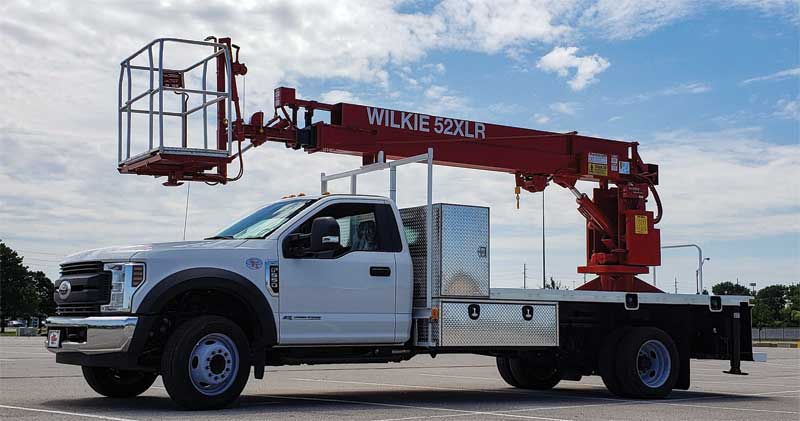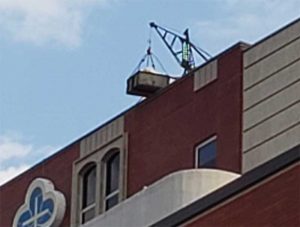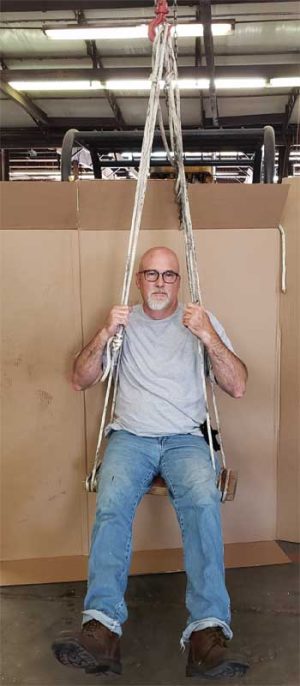Evolution of the Modern Sign Truck
by | 5 September 2019 3:16 pm
By Bryan Wilkerson
 [1]
[1]Today’s sign trucks feature everything one would find in a luxury car. Apart from convenience, these items have definitely made the sign installer’s life much easier, safer, and more efficient.
The evolution of the modern sign truck began at the dawn of the electric sign age when craftsmen demonstrated their talent with a mere paint brush. The journeymen of the time performed ‘elevated’ installations using scaffolds, block and tackle, or straight ladders lashed together to reach soaring heights. With time, of course, the size and complexity of signs multiplied tenfold, going from simple circus tent type canvases to large boards, swinging structures and, finally, to modern-day signage, which includes light-emitting diodes (LEDs), motion, changeable copy, moulded accents, and gilding. As times changed, signs, too, assumed enormous proportions; some completely covered the building’s façade, lending themselves to the overall architectural design. These developments led the way to even greater needs, resources, and workload on the part of the sign installer.
Humble beginnings
The gin pole lifting device existed even before the invention of the working sign truck. Here, two parallel poles formed a triangle with a pulley at the end, which was used for lifting both the pole and sign. Most of these sign installation devices were originally driven by hand-crank systems, eventually leading to an electric system—usually of the 12-volt nature. Later models used a power takeoff (PTO) method, which took power from a source (or engine of the truck) and transmitted it to the device. Today, gin pole trucks are no longer seen in the sign industry, primarily due to the amount of time they took to rig a unit. Also, lifting could only be done directly off the back of the truck as it did not allow any rotation or side reach to the equipment. Although these units were very strong and could lift heavy weights, these disadvantages gradually led to them being phased out as more modern and flexible cranes entered the workplace.
The sign installer’s lifting capabilities initially started out with a block and tackle attached to a scaffolding system, slowly progressing to hand-crank driven gin poles (followed by truck-mounted devices), and finally the hand-crank telescoping crane. The latter, too, moved on to electric cranes with 12, 110, or (in some rare cases) 220-volt alternating current (AC). These units eventually gave way to hydraulic cranes, which did not include any rotating or vibrating structures (such as cables rolling over the next reeve in a cable reel).
The smooth actuation of hydraulic cylinders soon replaced previous mechanisms. This new method allowed equal force all the way through the unit’s motion and could also be equipped with a ‘soft’ start or stop. This meant the motion would start off slowly at first, increase in speed, and then slow down at the end of the operation.
Reaching greater heights
 [2]
[2]The journeymen of the time performed ‘elevated’ installations using scaffolds, block and tackle, or straight ladders lashed together to reach soaring heights.
At first, elevation for sign installation jobs was either accomplished with the help of an actuating screw or a hydraulic cylinder. As stem/brass bushing bases gradually moved to ball bearing turntables, truck-mounted aerial ladders started becoming popular for reaching greater heights. These units slowly replaced Boatswain chairs, or swinging planks, that were used at the end of the crane’s load line cable. This chair consisted of a piece of wood secured on either side of the seat and attached to the crane, which would elevate the installer to the desired height. This, however, was dangerous as there was nothing holding the person in place except for (maybe) an extra rope tied around his/her waist and, later on, a safety belt. However, this was not very safe, especially if the installer was distracted or a strong gust of wind began to sway the platform. The worker could potentially crash into the sign he/she was working on, get caught up in the equipment and be suspended by one of their limbs until he/she was lowered to the ground, or (in worst-case scenarios) slip and fall off the platform.
The invention of the modern aerial ladder transformed these situations to a safe and stable one-person job. Here, the raised work platform was fixed to a rigid structure, which allowed greater stability as the installer performed his/her job. This further reduced labour and improved speeds for setup, creating a whole new industry of people that strictly specialized in service installation.
Staggering progress
 [3]
[3]A Boatswain chair consisted of a piece of wood secured on either side of the seat and attached to the crane, which would elevate the installer to the desired height.
The introduction of the hydraulic crane brought with it additional features, including an oversized rotating basket for holding two or more people. A larger work platform meant greater flexibility—an extra set of hands to hold a bigger sign in place or additional material to be carried up if there was only one person in the basket. Another advantage of this basket was the ability to position the sign truck in one location, so the installer could start on one end of the wall and slowly work his/her way across the face of the building. Since the front of the basket stayed parallel to the wall at all times, the worker did not have to lean over the edge of the platform to reach the sign he/she was working on. These baskets became more commonplace as channel letters increased in popularity within the industry.
Soon after this, winch-operated jib cranes and trucks with 180-degree rotation baskets appeared on the scene. These allowed the installer to raise a letter up into place and position it without using his/her hands, or for a sign that was too heavy to lift manually. These devices were lighter and quicker than the main hoists used previously, as they were designed keeping service and light installation requirements in mind. Additional accessories, such as a 110-volt outlet in the basket, became much more common and allowed the use of power tools, such as drills and saws, from within the structure itself. They also allowed workers to conduct electrical tests on signs before they were connected to the main circuits of a pole or building. Welding leads in the basket were helpful when using staggered poles—also known as wedding cake poles—where one pole was lifted from inside the other and welded in place to reach a greater height.
It was around this time pressure washers started to make an appearance. These devices were used to clean algae or mould growth inside awnings and double-faced signs. In this case, a professional was required to come in once or twice a year, turn off the power, open up the faces, and wash the inside of the sign to keep them from developing black spots, which showed up when the sign was illuminated.
Signs of success
Sign truck beds have also changed with the times. Today, it is almost impossible to find a truck set up with hand-painted or printed plywood shelving for large hoardings. Panel signs with front lighting phased out in the ’70s and ’80s, with the exception of a few billboards. Giant chicken wire racks used for large neon signs are not seen anymore, as porcelain and neon, too, gave way to modern pan-faced signs with LED or fluorescent lighting.
Stabilizing jacks or outriggers—used for keeping trucks in position—have also undergone a tremendous change over the years. Today, it is very common to see hydraulic outriggers that are independently controlled; some even have sensors tied to computer levelling systems. That said, sign trucks themselves have evolved in the last 20 to 30 years. In fact, almost no one orders a truck without air conditioning and a radio anymore. These were considered over-the-top luxury items back then. Today’s trucks feature everything from Global Positioning System (GPS) to onboard cameras, remotely guided spotlights for after-hours work, sunroofs to increase visibility when positioning the truck, cruise control, tilt steering, and custom ride seats for long-haul service calls—everything one would
find in a luxury car. Apart from convenience, these items have definitely made the sign installer’s life much easier, safer, and more efficient.
Bryan Wilkerson is vice-president at Wilkie Mfg LLC in Oklahoma. He has been in the industry for 32 years and has been a member of several sign association boards. He is also an advisor to the crane safety board for the Canadian Standards Association (CSA). Wilkerson can be reached at bryan@wilkiemfg.com. For more information, visit www.wilkie mfg.com.
- [Image]: https://www.signmedia.ca/wp-content/uploads/2019/09/20190531_120529-3.jpg
- [Image]: https://www.signmedia.ca/wp-content/uploads/2019/09/20190621_071609-2.jpg
- [Image]: https://www.signmedia.ca/wp-content/uploads/2019/09/20190627_100733-2.jpg
Source URL: https://www.signmedia.ca/evolution-of-the-modern-sign-truck/